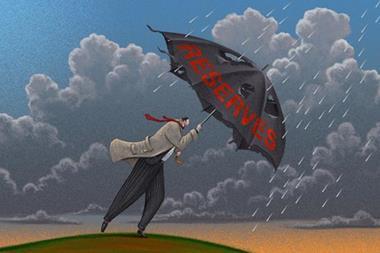The Brit Insurance takeover looks set to herald a surge in M&A activity – and it’s shareholders who will be calling the shots
Brit Insurance’s submission to a hostile takeover bid from a private equity company looks set to be followed by a flurry of mergers and acquisitions. Aviva and The Royal Bank of Scotland are just two of the firms to watch: RSA is understood to be gearing up for another go at Aviva’s general insurance business, having had a £5bn offer rejected in the summer. Meanwhile, RBS appears to be considering selling off bits of its insurance business even before 2013, the deadline by which the EU has said the government-owned entity must sell or float. Deals already completed this year include the merger of Harbor Point and Max Capital to create £2bn global property and casualty (re)insurer Alterra.
The plethora of potential M&As means our Top 50 could look quite different next year. But insurers’ shares are generally thought to be undervalued at the moment, a situation that could be exacerbated if the reserves they
have been using over the past few years to enhance their profits effectively run out, as widely feared. This means that, while many management teams will not want to sell, they may have no choice.
So who has the ultimate power to decide which deals will go ahead in the coming months – and which firms could be swallowed up?
Where the power lies
PricewaterhouseCoopers partner Paul Clarke says that, although numerous factors will drive takeovers, above all, shareholders call the shots. This, after all, is how private equity firms Apollo and CVC Capital Partners were able to acquire Brit in October, against its management’s wishes, with a cash offer valuing the firm at £11 a share. “If shareholders want to sell a company, it will go. For example, if someone comes in with a stupid price for Aviva, it will be sold.”
Beazley is currently pursuing rival Lloyd’s insurer Hardy Underwriting in a similar way, appealing directly to the firm’s shareholders. A Beazley spokesman says: “The shareholders are sovereign, so we have been encouraging them to talk to the management.”
The power of shareholders over a single company increases if there are fewer of them.
If only a handful of entities hold large stakes, the buyer need only convince a few people to sell. Shore Capital analyst Eamonn Flanagan says: “If you take a company like RSA, seven institutions hold stakes of between 4% and 5% (Standard Life, for example, holds 4.4%). This amounts to about 35% of the company, so basically you can get a deal to happen by making seven phone calls.”
Chaucer Insurance, in which private equity fund Pamplona Capital Management holds a 17% stake, is even more vulnerable: “It will not last long – one phone call would do it,” Flanagan speculates.
Flanagan adds that RSA’s Aviva bid – which he argues was a “terrific deal for shareholders” – probably failed because Aviva did not have a single large investor. “There is no one big player who could rattle the cage a bit.” As a result, Aviva’s management had an unusually large influence and were able to fend off the acquisition. Whether they’ll pull this off in the face of future bids remains to be seen, especially as Aviva shareholders, including Royal London Asset Management and Standard Life, have already complained that the bid was rejected too hastily.
Equally, the buyer’s own shareholders have considerable power to stop a deal. Ian Overgage, spokesman for the Association of Investment Companies, says: “Companies may be keen to spend money on acquisitions but they will always need shareholder support for these actions. Ultimately, shareholders have the power to approve or reject board recommendations.”
Flanagan points to Prudential’s failed attempt to buy AIA in Asia earlier this year for $35.5bn (£22.4bn). The monster deal was scuppered because “one of Prudential’s shareholders, Capital Group, was against it and they had a huge say since they held a 15% stake”.
Losing patience
So exactly how hungry are shareholders for deals? In short, ravenous. Flanagan says that, although most insurers are trading below book (that is, they would sell for less than their annual premium), “there will be huge pressure from shareholders for insurance companies to make deals next year”.
He cites an ominous change of mood among investors: “They are losing patience with the sector as they are seeing some insurers sitting on huge piles of capital and neither returning it nor using it to fund acquisitions, while others, seen as the good guys, are paying dividends.”
This mood looks set to sour even further in 2013 when Solvency II comes into effect because its requirement for insurers to hold greater reserves will make them less likely to pay dividends. The regulations will also hit their ability to release reserves in order to boost profit figures.
Extra pressure still is set to come from private equity houses that hold shares, as many are reaching the end of three- and five-year investment cycles and are now under pressure from their own investors either to make new investments or return capital.
It’s also true that some insurers’ management boards may welcome a merger, particularly those that need to increase their reserves under the Solvency II rules. Clarke says: “Monoline insurers will be most affected by the new capital requirements. A small motor insurer, for example, would be on relatively tight solvency margins and might have to do a merger or acquisition in order to increase its capital.”
Similarly, insurers specialising in shorter tail lines, which tend to have smaller reserves due to the more predictable nature of the business, may seek to tie up with companies with longer tails and hence bigger reserves.
The opposite may happen too: firms may try to reduce the risk associated with a substantial book of long-tail claims by doing a deal with a short-tail specialist – especially when Solvency II means that they have to be more prudent.
This appears to be part of Beazley’s motivation for trying to buy Hardy. Flanagan says: “Beazley is trying to bring back its tail a bit through this deal.”
Another driver of M&As in the coming months could be the underwriting cycle: with prices lingering in the doldrums, merely increasing the volume of sales will fail to bring growth. However, the fact that insurers are trading at a discount will probably dampen the enthusiasm for a deal for a board whose sole motivation is growth.
So the main driver of M&As over the next 12 months will be shareholders, and the sector should brace itself because they mean business. Flanagan warns: “A lot of people will no longer want to be invested in insurance companies – things are about to get tough for the industry.” IT
How to avoid a takeover
Look after your shareholders, so they will want to stick with you. This means paying dividends and investing capital wisely.
Maintain the lines of communication with shareholders. You'll have a better chance of negotiating with them should a potential deal come up and they are less likely to bypass the board and respond to public statements from the would-be buyer.
Run a tight ship. Quality products and a good underwriting record will make shareholders want to hang on to their stake, says Eamonn Flanagan of Shore Capital.
Allow shareholders to buy more shares at a discount. This is a more controversial, last-ditch mechanism, known as a poison pill. The idea is that it will dilute the shares and make the takeover more difficult and expensive.
Hosted by comedian and actor Tom Allen, 34 Gold, 23 Silver and 22 Bronze awards were handed out across an amazing 34 categories recognising brilliance and innovation right across the breadth of UK general insurance.













































